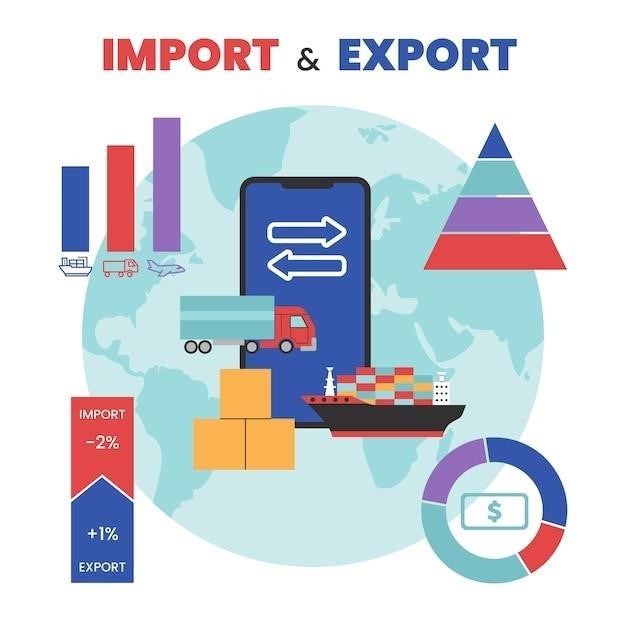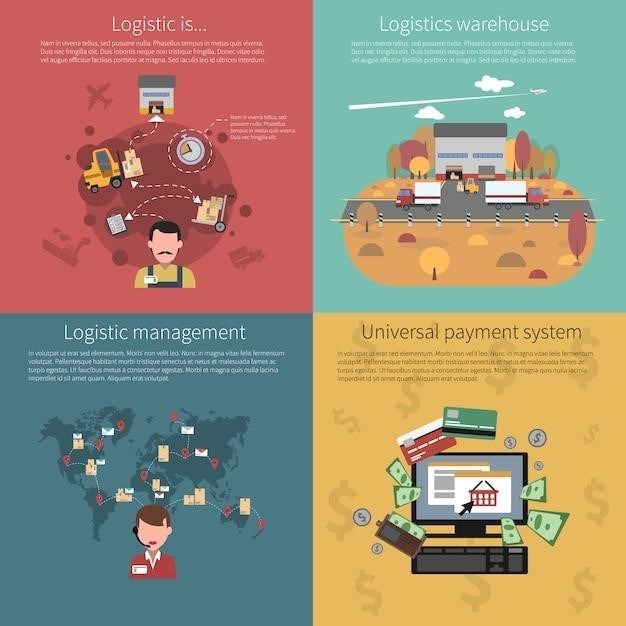Operations Management and Supply Chain Management⁚ An Overview
Numerous online PDFs detail operations management and supply chain management. These resources cover diverse topics, including strategic capacity management, supply chain strategy alignment with business goals, and the crucial role of forecasting in supply chain planning.
Defining Operations Management and Supply Chain Management
Operations management (OM) encompasses the administration of business practices to create the highest level of efficiency possible within an organization. It involves the design, implementation, and control of processes that transform inputs into goods and services. Key aspects include production planning, inventory management, quality control, and process improvement. Many online PDFs illustrate these concepts with real-world examples and case studies.
Supply chain management (SCM), a broader concept, integrates all activities associated with the flow of goods and services, from origin to final consumption. It goes beyond the internal operations of a single firm, encompassing the management of relationships with suppliers, manufacturers, distributors, and retailers. Effective SCM aims to optimize the entire network, ensuring timely delivery, cost efficiency, and customer satisfaction. Numerous academic and industry PDFs explore SCM strategies and their impact on organizational performance. The interplay between OM and SCM is significant, with OM forming a core component within the larger SCM framework.
Key Differences Between Operations and Supply Chain Management
While interconnected, operations management (OM) and supply chain management (SCM) possess distinct focuses. OM primarily concentrates on internal processes within a single organization, optimizing production, resource allocation, and quality control. SCM, conversely, adopts a broader, external perspective, encompassing the entire network of organizations involved in product creation and delivery. This includes suppliers, manufacturers, distributors, and retailers. Many online PDFs highlight this distinction, showcasing how OM focuses on efficiency within a firm, while SCM emphasizes collaboration and coordination across the entire supply chain.
Another key difference lies in their scope. OM’s scope is largely internal, dealing with production lines, inventory levels, and quality assurance. SCM, however, encompasses the entire flow of goods and information, from raw material sourcing to end-customer delivery. This broader view necessitates managing relationships with external partners and considering global factors impacting the supply chain. These differences are often illustrated in PDFs through comparative case studies, emphasizing the unique contributions of OM and SCM to overall business success.
The Intertwined Nature of Operations and Supply Chain Management
Despite their differences, operations management (OM) and supply chain management (SCM) are deeply intertwined. Effective SCM relies heavily on efficient OM practices within individual organizations. A smoothly functioning internal operation is crucial for meeting customer demands and maintaining timely deliveries, key elements of successful SCM. Many academic PDFs emphasize this synergy, illustrating how internal operational efficiency directly translates to improved supply chain responsiveness and reduced lead times.
Conversely, a well-designed SCM significantly enhances OM’s effectiveness. By ensuring a steady flow of materials and information, SCM reduces operational disruptions, minimizes inventory costs, and allows for better production planning. The integration of OM and SCM is often depicted in online PDFs through models showcasing how streamlined processes throughout the entire supply chain, from procurement to delivery, contribute to improved overall performance and increased profitability for the entire network of businesses involved.
Strategic Aspects of Operations and Supply Chain Management
Many PDFs highlight strategic capacity management and its importance in aligning supply chain strategy with overall business goals. Forecasting plays a pivotal role in effective supply chain planning, impacting resource allocation and operational efficiency.
Strategic Capacity Management and its Importance
Numerous online PDFs emphasize the critical role of strategic capacity management within the broader context of operations and supply chain management. Effective capacity planning ensures that an organization possesses the necessary resources—including personnel, equipment, and facilities—to meet current and future demand. This involves a careful analysis of various factors, such as market forecasts, production lead times, and technological advancements. Inadequate capacity planning can lead to lost sales opportunities, increased production costs, and diminished customer satisfaction. Conversely, overcapacity can result in excessive overhead and reduced profitability; Therefore, achieving an optimal balance between capacity and demand is crucial for long-term success. Strategic capacity management often involves a combination of quantitative and qualitative techniques, such as linear programming, simulation modeling, and scenario planning. These tools enable managers to make informed decisions regarding capacity expansion, contraction, or modification. The ultimate goal is to create a flexible and responsive capacity that can adapt to changing market conditions while maintaining a competitive edge.
Supply Chain Strategy and its Alignment with Business Goals
Many readily available PDFs on operations and supply chain management highlight the vital connection between a robust supply chain strategy and an organization’s overall business objectives. A well-defined supply chain strategy should seamlessly integrate with the company’s broader strategic goals, ensuring that the supply chain actively contributes to the achievement of those goals. This alignment requires a comprehensive understanding of the business’s vision, mission, and market position. Key performance indicators (KPIs) specific to the supply chain, such as on-time delivery, inventory turnover, and cost efficiency, should be directly linked to overall business metrics, such as revenue growth, profitability, and market share. The development of a successful supply chain strategy often involves a collaborative effort across different functional areas within the organization, including procurement, production, logistics, and sales. This collaborative approach fosters communication and information sharing, leading to better decision-making and improved performance. A well-aligned supply chain strategy empowers businesses to gain a competitive advantage by optimizing efficiency, enhancing responsiveness, and improving customer satisfaction.
The Role of Forecasting in Supply Chain Planning
Numerous online PDFs emphasize the critical role of forecasting in effective supply chain planning. Accurate forecasting provides the foundation for informed decision-making across all aspects of the supply chain, from procurement and production planning to inventory management and logistics. By predicting future demand, businesses can optimize their resource allocation, minimizing waste and maximizing efficiency. Different forecasting methods, ranging from simple moving averages to sophisticated statistical models, are employed depending on the complexity of the product, market dynamics, and data availability. The accuracy of forecasts significantly impacts inventory levels, production schedules, and transportation arrangements. Overestimating demand leads to excess inventory and storage costs, while underestimating demand can result in stockouts, lost sales, and dissatisfied customers. Effective forecasting involves not only selecting the appropriate method but also incorporating qualitative factors, such as market trends, economic conditions, and seasonal variations, into the forecasting process. Continuous monitoring and evaluation of forecasting accuracy are crucial for ensuring the ongoing effectiveness of the supply chain planning process.

Operational Aspects of Operations and Supply Chain Management
Many online PDFs explore operational aspects, including inventory management techniques, production planning and control systems, and the impact of logistics on supply chain efficiency.
Inventory Management Techniques and their Applications
Numerous online PDFs dedicated to operations and supply chain management delve into various inventory management techniques and their practical applications. These resources often discuss the importance of balancing inventory holding costs against the risk of stockouts. Commonly analyzed techniques include Economic Order Quantity (EOQ), which helps determine optimal order sizes to minimize total inventory costs, and Just-in-Time (JIT) inventory systems, focusing on minimizing inventory levels by receiving materials only when needed for production. The PDFs also explore safety stock calculations to buffer against demand variability and lead time uncertainty, and sophisticated inventory control models that incorporate forecasting and demand planning. Furthermore, the role of technology, such as barcode scanning and RFID, in improving inventory tracking and accuracy is frequently highlighted. Discussions often extend to the application of these techniques across different industry sectors, illustrating how effective inventory management contributes to improved efficiency and profitability.
Production Planning and Control Systems
Many readily available PDFs on operations and supply chain management extensively cover production planning and control systems. These documents frequently detail Material Requirements Planning (MRP) systems, explaining how they help manage the flow of materials needed for production by calculating the quantities and timing of orders. The role of Enterprise Resource Planning (ERP) systems in integrating various aspects of a business, including production planning, is also frequently discussed. Furthermore, the PDFs often illustrate the use of different scheduling techniques, such as Gantt charts and critical path methods, for managing and monitoring production processes. Lean manufacturing principles and their impact on production planning and control are commonly explored, emphasizing the importance of minimizing waste and improving efficiency. The analysis often includes discussions on capacity planning and its relation to production schedules, along with methods for managing production capacity to meet demand while optimizing resource utilization. Detailed case studies often demonstrate the practical application of these systems in various manufacturing and service settings.
Logistics and its Impact on Supply Chain Efficiency
Numerous online PDFs dedicated to operations and supply chain management emphasize the critical role of logistics in optimizing supply chain efficiency. These resources often highlight the various components of logistics, including transportation management, warehousing, inventory control, and order fulfillment. The impact of efficient logistics on reducing lead times, minimizing transportation costs, and improving on-time delivery is frequently analyzed. The use of technology in logistics, such as transportation management systems (TMS) and warehouse management systems (WMS), is often discussed, illustrating how these systems enhance visibility and control throughout the supply chain. Furthermore, the PDFs often explore different logistics strategies, such as just-in-time (JIT) delivery and third-party logistics (3PL) partnerships, and their effect on supply chain performance. The importance of effective communication and collaboration among different stakeholders in the logistics network, including suppliers, manufacturers, distributors, and customers, is also a recurring theme. Case studies and real-world examples frequently demonstrate the significant benefits of well-managed logistics in achieving a competitive advantage.

Analyzing Operations and Supply Chain Management PDFs
Online PDFs offer valuable insights into operations and supply chain management. Analyzing these resources allows for a deeper understanding of key concepts and practical applications.
Common Themes Found in Operations and Supply Chain Management Textbooks
Analysis of numerous Operations and Supply Chain Management (OSCM) PDFs reveals recurring themes. Many textbooks emphasize the integrated nature of operations and supply chain management, highlighting the interdependence of various functions within an organization and its external relationships. Strategic decision-making consistently emerges as a crucial element, encompassing capacity planning, supply chain network design, and aligning supply chain strategies with broader business objectives. The importance of effective forecasting in mitigating supply chain disruptions and optimizing inventory levels is another frequently discussed topic. Furthermore, a significant portion of textbooks dedicates space to operational aspects, including inventory management techniques such as Just-in-Time (JIT) and Economic Order Quantity (EOQ), production planning and control systems like Material Requirements Planning (MRP) and Enterprise Resource Planning (ERP), and the role of logistics in enhancing supply chain efficiency. The complexities of global supply chain operations and the challenges of sustainability are also prevalent themes, reflecting the evolving landscape of OSCM. Finally, many texts include case studies illustrating real-world applications of OSCM principles, providing practical insights and valuable learning experiences for students.
Analyzing Case Studies Presented in Academic Literature
Analyzing case studies within Operations and Supply Chain Management (OSCM) PDFs offers valuable insights. These studies often present real-world scenarios, allowing for a deeper understanding of complex OSCM concepts. By examining the challenges faced by companies, students can learn how theoretical frameworks translate into practical application. Effective analysis involves identifying key decision points, evaluating the effectiveness of chosen strategies, and assessing the outcomes. Furthermore, comparing and contrasting different case studies reveals common themes and best practices. Analyzing the successes and failures highlighted in these studies aids in developing critical thinking skills and problem-solving abilities. The detailed narratives within case studies provide rich contextual information, allowing for a nuanced understanding of the factors influencing OSCM decisions. Critically examining the data presented, methodologies used, and conclusions drawn enhances analytical skills. The diverse range of industries and organizational contexts represented in these case studies broadens students’ understanding of the applicability of OSCM principles across various sectors.
Utilizing PDFs for Practical Application of Concepts
Operations and Supply Chain Management (OSCM) PDFs are invaluable tools for practical application. Many PDFs contain real-world examples, case studies, and exercises that allow readers to test their understanding of theoretical concepts. By working through these practical applications, readers can solidify their knowledge and develop problem-solving skills. Some PDFs include interactive elements, such as simulations or quizzes, which provide immediate feedback and reinforce learning. The accessibility of PDFs allows for convenient self-study and review. Readers can easily search for specific topics or revisit challenging concepts as needed. Furthermore, PDFs often include supplementary materials, such as spreadsheets or templates, which can be used to practice applying OSCM techniques. The ability to annotate and highlight key information within PDFs enhances the learning process. By actively engaging with the material in this way, readers can personalize their learning experience and tailor it to their individual needs. The diverse range of OSCM PDFs available online caters to various learning styles and levels of expertise, ensuring that there is a suitable resource for everyone;



